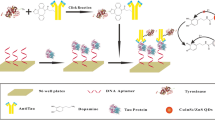Abstract
A fluorescence technology to monitor the proliferation of amyloidogenic neurological disorders is proposed. A crude brain homogenate (0.01%) from animals infected with a transmissible spongiform encephalopathy is employed as a catalytic medium initiating conformational changes in 520 nM polypeptide biosensors (Tris/trifluoroethanol 50% mixture at pH 7). The fluorescence methods utilize pyrene residues covalently attached to the peptide ends. The coil-to-β-strand transitions in biosensor molecules cause elevation of a distinct fluorescence band of the pyrene aggregates (i.e. excimers). This approach enables the detection of infectious prion proteins at fmol, does not require antibody binding or protease treatment. Technology might be adopted for diagnosing a large variety of conformational disorders as well as for generic high-throughput screening of the amyloidogenic potential in plasma.
Similar content being viewed by others
References
P Bross N Gregersen (2003) Basic introduction to in vivo protein folding and its defects P Bross N Gregersen (Eds) Protein Misfolding and Disease: Principles and Protocols. Methods in Molecular Biology, Vol. 232. Humana Press Clifton, NJ 17–26
F Chiti M Stefani N Taddei G Ramponi CM Dobson (2003) ArticleTitleRationalization of the effects of mutations on peptide and protein aggregation rates Nature 424 805–808 Occurrence Handle10.1038/nature01891 Occurrence Handle1:CAS:528:DC%2BD3sXmt1ant70%3D Occurrence Handle12917692
FE Cohen SB Prusiner (1998) ArticleTitlePathologic conformations of prion proteins Annu. Rev. Biochem. 67 793–819 Occurrence Handle10.1146/annurev.biochem.67.1.793 Occurrence Handle1:CAS:528:DyaK1cXlsFOmsbc%3D Occurrence Handle9759504
CM Dobson (2001) ArticleTitleThe structural basis of protein folding and its links with human disease Phil Trans R. Soc. Lond. B 356 133–145 Occurrence Handle10.1098/rstb.2000.0758 Occurrence Handle1:CAS:528:DC%2BD3MXjt1Wjsbc%3D
R Jackman MJ Schmerr (2003) ArticleTitleAnalysis of the performance of antibody capture methods using fluorescent peptides with capillary zone electrophoresis with laser-induced fluorescence Electrophoresis 24 892–896 Occurrence Handle10.1002/elps.200390112 Occurrence Handle1:CAS:528:DC%2BD3sXisVKqsrs%3D Occurrence Handle12627452
R Kisilevsky (2000) ArticleTitleAmyloidogenesis-unquestioned answers and unanswered questions J. Struct. Biol. 130 99–108 Occurrence Handle10.1006/jsbi.2000.4222 Occurrence Handle1:CAS:528:DC%2BD3cXls1antbg%3D Occurrence Handle10940218
C Korth B Stierli P Streit M Moser O Schaller R Fischer W Schulz-Schaeffer H Kretzschmar A Raeber U Braun F Ehrensperger S Hornemann R Glockshuber R Riek M Billeter K Wuthrich B Oesch (1997) ArticleTitlePrion PrPSc-specific epitope defined by a monoclonal antibody Nature 390 74–77 Occurrence Handle10.1038/36337 Occurrence Handle1:CAS:528:DyaK2sXnt1Crtr8%3D Occurrence Handle9363892
N Morel S Simon Y Frobert H Volland C Mourton-Gilles A Negro MC Sorgato C Creminon J Grassi (2004) ArticleTitleSelective and efficient immunoprecipitation of the disease-associated form of the prion protein can be mediated by nonspecific interactions between monoclonal antibodies and scrapie-associated fibrils J. Biol.Chem. 279 30143–30149 Occurrence Handle10.1074/jbc.M403896200 Occurrence Handle1:CAS:528:DC%2BD2cXlsFKitL4%3D Occurrence Handle15140886
E Paramithiotis M Pinard T Lawton S LaBoissiere VL Leathers WQ Zou LA Estey J Lamontagne MT Lehto LH Kondejewski GP Francoeur M Papadopoulos A Haghighat SJ Spatz M Head R Will J Ironside K Oȁ9Rourke Q Tonelli HC Ledebur A Chakrabartty NR Cashman (2003) ArticleTitleA prion protein epitope selective for the pathologically misfolded conformation Nat. Med 9 893–899 Occurrence Handle10.1038/nm883 Occurrence Handle1:CAS:528:DC%2BD3sXkvFOjsrg%3D Occurrence Handle12778138
S Tazaban G Friedlander O Schonberger L Horonchik Y Yedidia G Shaked R Gabizon A Taraboulos (2002) ArticleTitleProtease-sensitive scrapie prion protein in aggregates of heterogenous sizes Biochemistry 41 12868–12875 Occurrence Handle10.1021/bi025958g Occurrence Handle12379130
O Tcherkasskaya W Sanders V Chynwat EA Davidson CS Orser (2003) ArticleTitleThe role of hydrophobic interactions in amyloidogenesis: Example of prion-related polypeptides J. Biomol. Struct. Dyn. 21 353–365 Occurrence Handle1:CAS:528:DC%2BD3sXhtVWgsb3J Occurrence Handle14616031
T Yokoyama KM Kimura Y Ushiki S Yamada A Morooka T Nakashiba T Sassa S Itohara (2001) ArticleTitleIn vivo conversion of cellular prion protein to pathogenic isoforms, as monitored by conformation-specific antibodies J. Biol. Chem. 276 11265–11271 Occurrence Handle10.1074/jbc.M008734200 Occurrence Handle1:CAS:528:DC%2BD3MXjvFGjsb0%3D Occurrence Handle11152682
Acknowledgement
This work was supported by the NIH grant (1R43 HL70399-01).
Author information
Authors and Affiliations
Corresponding author
Rights and permissions
About this article
Cite this article
Tcherkasskaya, O., Davidson, E.A., Schmerr, M.J. et al. Conformational biosensor for diagnosis of prion diseases. Biotechnol Lett 27, 671–675 (2005). https://doi.org/10.1007/s10529-005-4478-7
Received:
Accepted:
Issue Date:
DOI: https://doi.org/10.1007/s10529-005-4478-7




